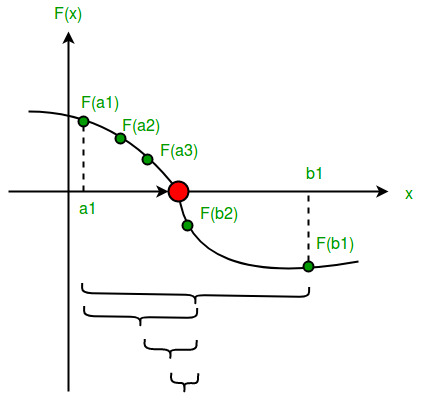FooPlot --> x*x*x - x*x + 2
https://www.wolframalpha.com Plot[(x^3 - x^2 + 2=0 ]
https://www.geeksforgeeks.org/program-for-bisection-method/
Program for Bisection Method
Given a function f(x) on floating number x and two numbers ‘a’ and ‘b’ such that f(a)*f(b) < 0 and f(x) is continuous in [a, b]. Here f(x) represents algebraic or transcendental equation. Find root of function in interval [a, b] (Or find a value of x such that f(x) is 0).
Example:
Example:
Input: A function of x, for example x3 - x2 + 2. And two values: a = -200 and b = 300 such that f(a)*f(b) < 0, i.e., f(a) and f(b) have opposite signs. Output: The value of root is : -1.0025 OR any other value with allowed deviation from root.
What are Algebraic and Transcendental functions?
Algebraic function are the one which can be represented in the form of polynomials like f(x) = a1x3 + a2x2 + ….. + e where aa1, a2, … are constants and x is a variable.
Transcendental function are non algebraic functions, for example f(x) = sin(x)*x – 3 or f(x) = ex + x2 or f(x) = ln(x) + x ….
Algebraic function are the one which can be represented in the form of polynomials like f(x) = a1x3 + a2x2 + ….. + e where aa1, a2, … are constants and x is a variable.
Transcendental function are non algebraic functions, for example f(x) = sin(x)*x – 3 or f(x) = ex + x2 or f(x) = ln(x) + x ….
What is Bisection Method?
The method is also called the interval halving method, the binary search method or the dichotomy method. This method is used to find root of an equation in a given interval that is value of ‘x’ for which f(x) = 0 .
The method is also called the interval halving method, the binary search method or the dichotomy method. This method is used to find root of an equation in a given interval that is value of ‘x’ for which f(x) = 0 .
The method is based on The Intermediate Value Theorem which states that if f(x) is a continuous function and there are two real numbers a and b such that f(a)*f(b) 0 and f(b) < 0), then it is guaranteed that it has at least one root between them.
Assumptions:
- f(x) is a continuous function in interval [a, b]
- f(a) * f(b) < 0
Steps:
- Find middle point c= (a + b)/2 .
- If f(c) == 0, then c is the root of the solution.
- Else f(c) != 0
- If value f(a)*f(c) < 0 then root lies between a and c. So we recur for a and c
- Else If f(b)*f(c) < 0 then root lies between b and c. So we recur b and c.
- Else given function doesn’t follow one of assumptions.
Since root may be a floating point number, we repeat above steps while difference between a and b is less than a value ? (A very small value).
Below is implementation of above steps.
// C++ program for implementation of Bisection Method for
// solving equations
#include<bits/stdc++.h>
using namespace std;
#define EPSILON 0.01
// An example function whose solution is determined using
// Bisection Method. The function is x^3 - x^2 + 2
double func(double x)
{
return x*x*x - x*x + 2;
}
// Prints root of func(x) with error of EPSILON
void bisection(double a, double b)
{
if (func(a) * func(b) >= 0)
{
cout << "You have not assumed right a and b\n";
return;
}
double c = a;
while ((b-a) >= EPSILON)
{
// Find middle point
c = (a+b)/2;
// Check if middle point is root
if (func(c) == 0.0)
break;
// Decide the side to repeat the steps
else if (func(c)*func(a) < 0)
b = c;
else
a = c;
}
cout << "The value of root is : " << c;
}
// Driver program to test above function
int main()
{
// Initial values assumed
double a =-200, b = 300;
bisection(a, b);
return 0;
}
Output:
The value of root is : -1.0025








沒有留言:
張貼留言